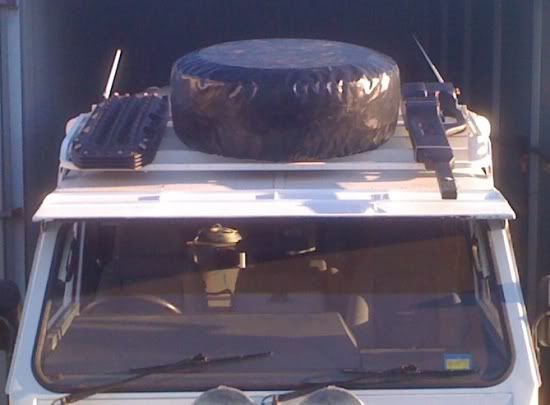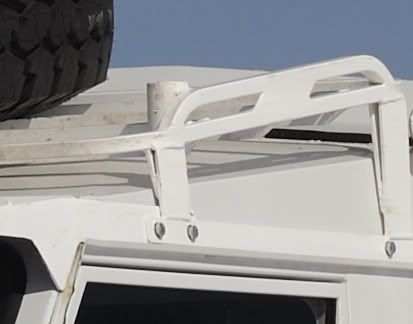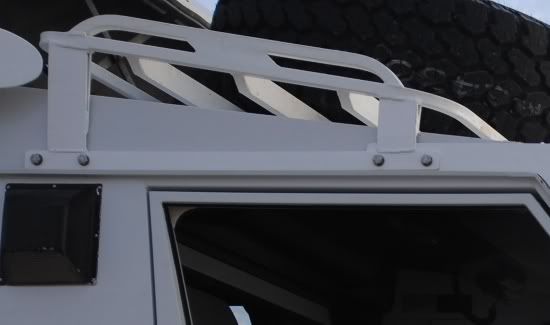nick disjunkt
Adventurer
Hi all,
I am in the process of converting my truck into a motorhome and am wrestling with ideas regarding the storage of a mounted spare tyre.
The truck is a Merc 1823 and so has a typical flat fronted European cab sitting over the engine. Below is an old photo showing the cab and box arrangement pretty much how it looked when I brought the truck.

There is absolutely no space along the chassis rails to fit a spare (batteries, air tanks, generator, fuel tanks, and exhaust silencer fill the space) and the back of the truck doesn’t lend itself well. There is no gap between the cab and the box so this option is also out.
The options I feel like I’m left with are:
1. inside the truck
2. On a rack over the roof of the cab
3 On a rack over the box
4. On a bull-bar mounted to the chassis/bumper at the front.
I don’t like option 1, I have limited space in the garage area under the bed at the back of the truck and the spare tyre would occupy most of it.
Option 2 seems reasonable but my cab already has significant excess weight over stock (it used to be a cash-in-transit vehicle) and I was worried about how the cab frame and mounts would deal with the additional weight of the rack, wheel and tyre (probably 250kg/500lb). It would be easy for me to mount a swing hoist to the front of the box. I see this option a lot on the expensive European 4x4 motorhomes from action mobil, unicat, ormocar, etc so I guess it works.
Option 3 seems like a bad idea as all that extra weight would be very high, it would also become the highest point on the truck. The hoist arm would have to be removable or it would stick up
Option 4 seems like the best idea to me but I don’t recall ever having seen it done. Any ideas why this is? The chassis rails are a strong fixing point for a suitable bull-bar mount and the weight would be very low. The wheel would block a little air flow to the radiator but I can’t see this being a problem. I’d have to fit a small winch to lower the wheel and bull-bar before I could tilt the cab but this is less of an engineering challenge than having a hoist to get the wheel and tyre onto a rack. I guess it would extend the length of the truck but I don’t plan on doing much shipping so it won’t be a huge concern.
Any reason I shouldn’t go for Option 4?
Anyone else been through the same design process and settled on a different option?
Thanks
Nick
I am in the process of converting my truck into a motorhome and am wrestling with ideas regarding the storage of a mounted spare tyre.
The truck is a Merc 1823 and so has a typical flat fronted European cab sitting over the engine. Below is an old photo showing the cab and box arrangement pretty much how it looked when I brought the truck.

There is absolutely no space along the chassis rails to fit a spare (batteries, air tanks, generator, fuel tanks, and exhaust silencer fill the space) and the back of the truck doesn’t lend itself well. There is no gap between the cab and the box so this option is also out.
The options I feel like I’m left with are:
1. inside the truck
2. On a rack over the roof of the cab
3 On a rack over the box
4. On a bull-bar mounted to the chassis/bumper at the front.
I don’t like option 1, I have limited space in the garage area under the bed at the back of the truck and the spare tyre would occupy most of it.
Option 2 seems reasonable but my cab already has significant excess weight over stock (it used to be a cash-in-transit vehicle) and I was worried about how the cab frame and mounts would deal with the additional weight of the rack, wheel and tyre (probably 250kg/500lb). It would be easy for me to mount a swing hoist to the front of the box. I see this option a lot on the expensive European 4x4 motorhomes from action mobil, unicat, ormocar, etc so I guess it works.
Option 3 seems like a bad idea as all that extra weight would be very high, it would also become the highest point on the truck. The hoist arm would have to be removable or it would stick up
Option 4 seems like the best idea to me but I don’t recall ever having seen it done. Any ideas why this is? The chassis rails are a strong fixing point for a suitable bull-bar mount and the weight would be very low. The wheel would block a little air flow to the radiator but I can’t see this being a problem. I’d have to fit a small winch to lower the wheel and bull-bar before I could tilt the cab but this is less of an engineering challenge than having a hoist to get the wheel and tyre onto a rack. I guess it would extend the length of the truck but I don’t plan on doing much shipping so it won’t be a huge concern.
Any reason I shouldn’t go for Option 4?
Anyone else been through the same design process and settled on a different option?
Thanks
Nick








